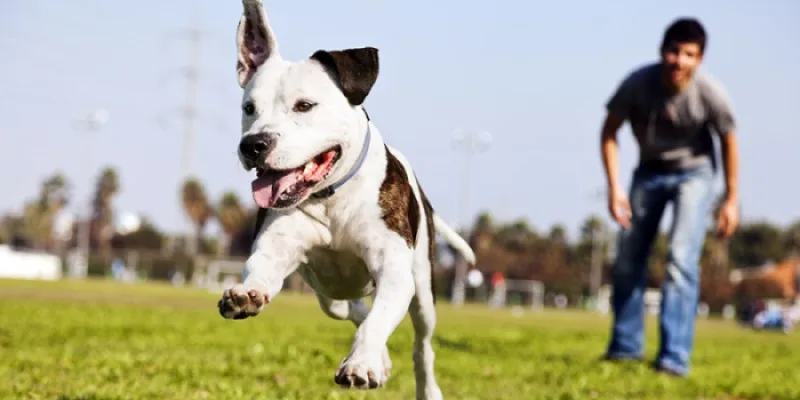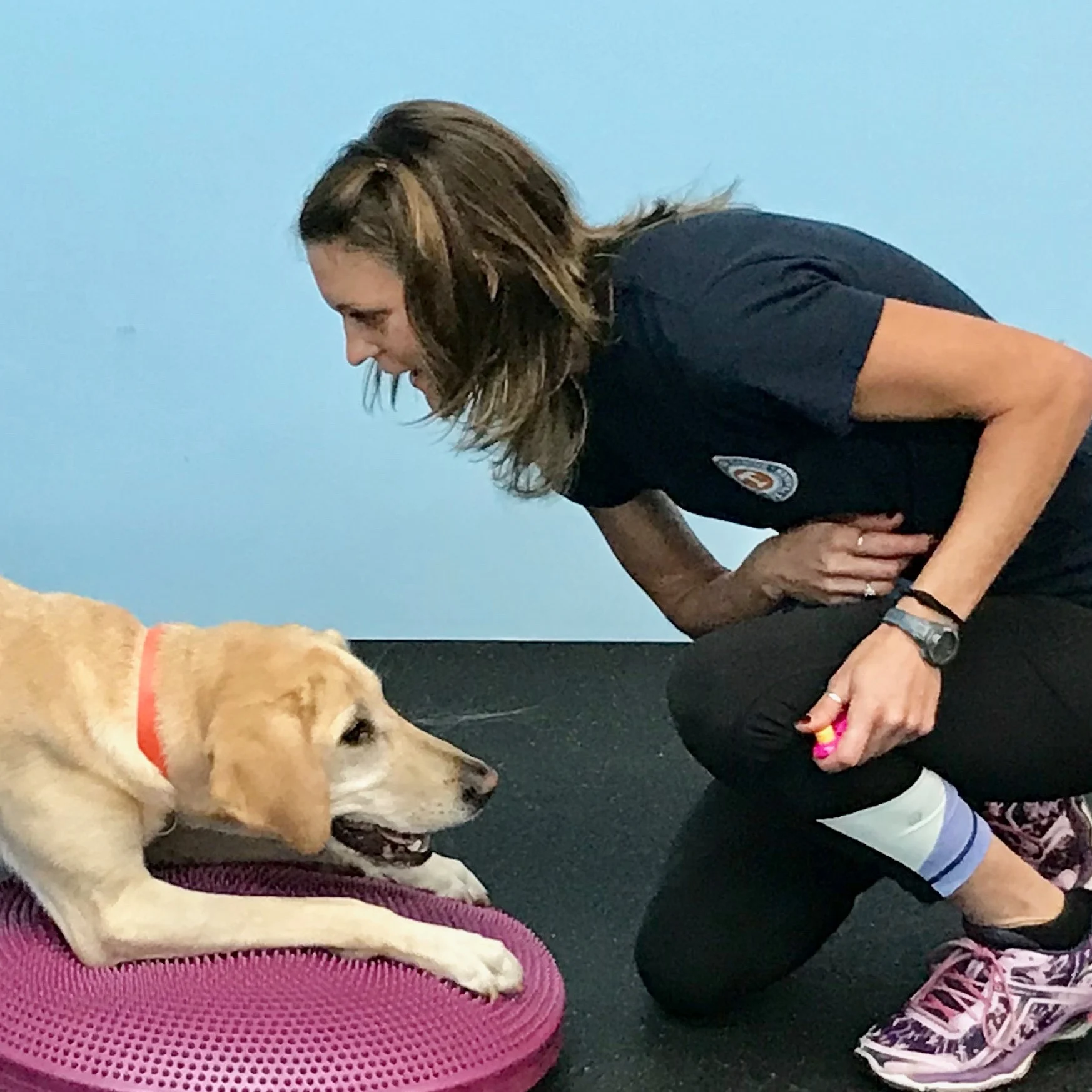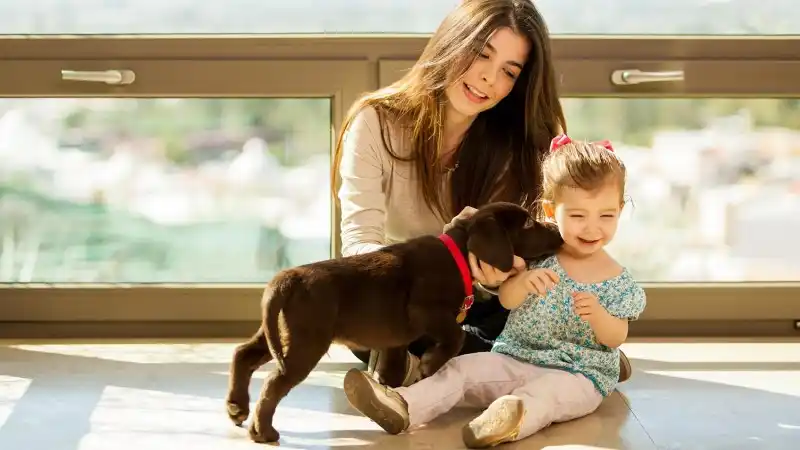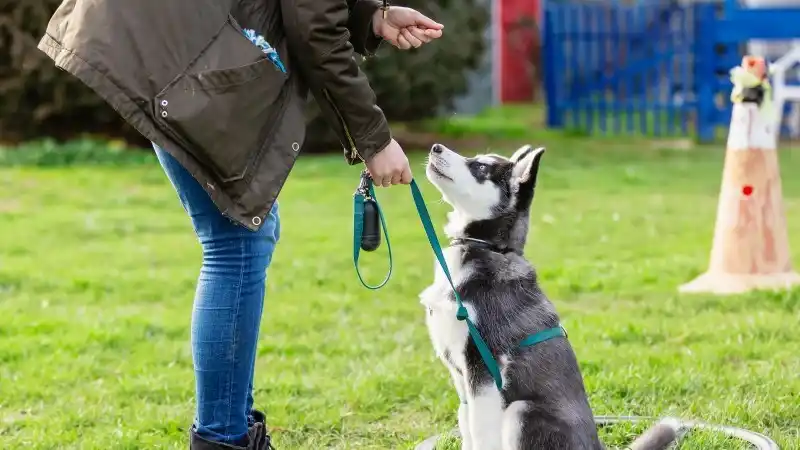Dog Park Safety Tips and Rules to Observe
Going to the dog park? Make sure you know these rules, as well as important dog park safety tips about vaccines, preventative meds, and behavior risks.

The weather is lovely and you can’t wait to see your dog enjoy some canine playtime, not to mention reap the benefits of a tired pup later. The dog park may be your best bet, since it can help socialize your dog and ensure that they get enough exercise and activity.
However, there are a few important things to be aware of before you make the trip. Below, we’ll answer questions about the best times to go to the dog park, offer some dog park safety tips and guidance on dog play, provide dog park rules for first-time visitors, and list some common dangers to avoid, both for puppies and older dogs.
What to Consider Before Going to the Dog Park
The local dog park may not be a great option for every dog. It's best to consider the following factors before making the trip:
Hot Weather. Dogs often play until they are worn out and can become overheated on hotter days. This makes mornings and evenings ideal since temperatures are cooler. It's safest to avoid hot, humid days when there is a high risk of heat stroke, unless you have a climate-controlled indoor dog park in your area.
Rain. Consider the mud and dirt associated with a rainy day. Dogs that frolic in the mud will need a bath when they get home. It might be best to play at your local indoor dog park or doggy daycare instead.
Age. Many dogs at the dog park are unvaccinated, and there is a risk of infectious diseases (such as parvovirus). This is especially true in unvaccinated or incompletely vaccinated puppies. The highest risk is for new puppies less than five months old. For young dogs, consider one-on-one play dates with healthy, vaccinated pups and save the dog park until they are five or six months old.
Pet Insurance: Enrolling your dog in a pet insurance policy when they’re young is a great way to prepare for the unexpected. It's especially helpful if you frequent the dog park, since anything goes when dogs meet for the first time.
Small Dog Section of the Park: If you have a smaller breed, many dog parks have sections for small canines so they are playing with dogs their own size. The same rules apply, but it’s worth trying this special section first.
Doggy Daycare: The advantage to doggy daycare is that you have staff keeping an eye on your dog at all times. These folks are trained to read body language and are an advocate for your dog, helping ensure that they aren’t injured during play.
Off Peak Hours. Visiting the park when there are fewer dogs is more enjoyable and helps avoid some undesirable or aggressive behavior. Try visiting early in the morning, later in the evening, or when other people are at work. Leave early -- and don't stay if the park is overcrowded.
Pro tip: If you find yourself asking, "When can I take my puppy to the dog park?" before your dog reaches five months of age, you should consider walks around town as a safe alternative. To learn more about walking in the city, check out our City Dog Walking Safety Guide.
11 Dog Park Safety Tips
To ensure a safe and fun trip, follow these dog park safety tips:
1. Know the Dog Park Rules
Off-leash dog parks have rules regarding dog size, vaccine requirements, collars, leashes, use of toys, and more. Know the rules for your off-leash park and make sure it's the right match. Aggressive dog behavior should never be tolerated. The rules and regulations are likely posted on your local park's site.
2. Teach Basic Commands
If your dog is used to tuning you out when they’re having fun, then you won’t be able to get their attention during a chaotic moment at the dog park. Have your dog do “sits” and “downs” during walks and even do a recall (“come”) command as well. Say “come” and then run backwards from your dog; when they reach you, reward them with treats. Eventually, transition these commands to various locations on and off-leash, with or without food rewards.
Another option is to see a professional dog trainer to continue practicing recall techniques. Group classes are fantastic for teaching your dog to listen in distracting environments and when around other dogs. Find a local class by using this link.
3. Don't Bring Dog Toys
Toys may give dogs something to “resource guard.” Some dog behaviorists advise against bringing toys to the dog park. If you decide to take along a plaything, bring extras for playmates.
4. Watch Dog Body Language
Leave if you see any dogs exhibiting aggression. Staring, crouching, and other tense body language is a warning sign. Rough play, like a group of aggressive dogs chasing another dog, is also very dangerous. Don’t forget to keep an eye on your dog's body language to ensure they're comfortable. This article further outlines both polite and impolite dog language.
5. Know When It’s Time to Leave
Have you ever seen a child get overtired? Suddenly, the laughter turns to tears, and tempers flare. A similar thing happens to dogs, resulting in rough play or an overly sensitive demeanor. Instead of staying for hours, go home before your dog reaches this point.
6. Don’t Zone Out
Both humans and dogs have to behave at the park. Pay attention to your dog. Do not engage in texting, social media, reading, or extensive human conversation. Keep your eyes on your dog to ensure there is no bad behavior or aggression.
7. Consider Dog Parks with Membership and Entrance Fees
Nice, clean dog parks often have fees for things like maintenance and licensing. In addition, these parks may verify vaccination records and ban those not playing nicely.
8. Bring a Well-Packed Bag
Many parks require that your dog always have a collar with identification and a license. Pack water, bowl, treats, leash, first-aid kit, poop bags, and towels. Encourage your dog to drink periodically to avoid dehydration. Keep a leash with you in case you need to control your dog or remove them from a situation. Treats can be great for basic training or rewarding your dog for good behavior. Towels can come in handy on a rainy day or if your dog gets dirty before getting back in the car.
9. Pick Up Poop
Many dog owners violate the golden rule of responsible dog ownership, and dog waste ends up on shoes and paws. Worse yet, poop may transmit disease. Dog owners who do not pick up poop ruin it for responsible dog owners.
If you see this kind of behavior, offer the person who didn’t pick up their dog’s poop one of your poop bags, pick up the abandoned dog poop of others, and always pick up your own dog’s poop.
10. Keep Up with Your Dog's Prevention Meds
Parks are full of dogs; many can have internal and external parasites. Ensure your dog is up to date on flea, tick, and heartworm prevention medications. Learn what you need to know about the dangers of ticks by reading our article about dogs and ticks here.
11. Make Sure Your Dog Is Healthy
Before going to the park, ensure your pup is well and not having abnormal symptoms, such as vomiting, diarrhea, sneezing, nasal discharge, or coughing, which can be contagious to other dogs. If they’re not in good spirits, a dog park isn’t the best place for them to be.

Every Dog and Cat Deserves the Pet Insurance of Champions
Get prize-winning care for your pets.
What Does Dog Play Look Like?
According to dog expert Marc Bekoff, “social play is an activity directed toward another individual in which actions from other contexts are used in modified forms and in altered sequences.” Yet, play can sometimes look scary to new and experienced dog owners. Play styles for different dogs vary, which is why areas for small dogs are so essential.
Play teaches dogs how to appropriately socialize with other dogs. Burghardt's five criteria of play can help pet owners understand the basics:
Play is voluntary
Play is pleasurable
Play is self-rewarding
Play is different structurally or temporally from related serious behavior systems (non-functional)
Play is initiated in benign situations
Dog Park Frequently Asked Questions
Can I Take My 12-Week-Old Puppy to the Dog Park?
Yes, but there are risks. A 12-week-old dog doesn’t have full immunity to diseases like parvovirus. The safest time to take your dog to the dog park is after their puppy vaccine series and your vet has cleared them.
What Vaccines Does My Dog Need If They Routinely Go to the Dog Park?
Your dog should be vaccinated for rabies, distemper/parvo (a combined vaccine often abbreviated as DHLPP), Bordetella (kennel cough), and the canine flu. Ask your vet for recommendations based on risks in your geographic location.
When Is the Best Time to Take Your Dog to the Dog Park?
For fully vaccinated canines current on flea and tick prevention medicine, any time can be a good time to enjoy the play area of your local dog park. However, during hot and humid months, the best time is in the morning or evening when temperatures are cooler, unless you have an indoor dog park near your home. Off-peak times, such as weekdays, are usually less busy.
Is it Safe to Take My Dog to the Dog Park During the COVID-19 Pandemic?
Follow all guidelines as dictated by the dog park and your own doctor. Use masks and social distancing as appropriate.
Can My Puppy Go to Dog Park After Their Second Set of Shots?
The answer depends on their age. If your dog is over four or five months of age, then it is probably safe. If your puppy is younger, then they haven’t had time to develop immunity to contagious diseases, increasing the risk of illness.
What Are the Benefits of Taking My Puppy to the Dog Park?
The primary benefit is that it allows for the dog-to-dog socialization process to begin and is a great way for your dog to exercise and blow off excess energy.
Finally, if you have a very small dog or very large dog, you may want to consider looking for parks that cater to their specific size. This will ensure the safety of smaller canines if a dog fight happens to break out.
Enjoy your visit to the dog park and stay safe!
Active Dogs Need Pet Insurance
Take some of the stress out of pet ownership with Accident & Illness Coverage from AKC Pet Insurance (underwritten by Independence American Insurance Company). Our dog pet insurance plans are designed to be there when you need them, allowing you to focus more on the health of your pet and less on costly veterinary bills.

Every Dog and Cat Deserves the Pet Insurance of Champions
Get prize-winning care for your pets.

Jasey Day holds the Certified Canine Fitness Trainer (CCFT) credential through the University of Tennessee. She is a member of the Bobbie Lyons K9FITteam - a team of compassionate canine fitness instructors who actively teach others and continually expand their own knowledge. Since 2004, Jasey has taught a variety of workshops and classes on the following: Puppy, Canine Good Citizen/Family Pet, Advanced Family Pet, Canine Fitness, Canine Swimming, Rally, and Agility. In addition, Jasey has earned over 60 titles in Dock Diving, Agility, Rally, CGC and Trick Dog. Jasey has worked full time for the American Kennel Club since 2007 and teaches at Care First Animal Hospital in Raleigh, NC. Jasey’s Labrador Retrievers spend their free time hiking, training, and snuggling with Jasey.
READ MORE ARTICLES

